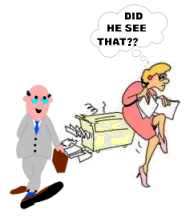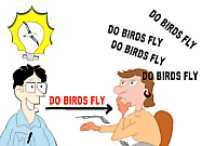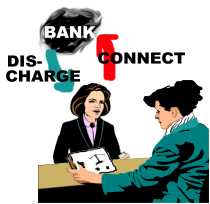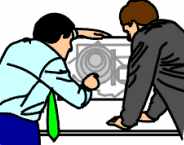|
Note: This is often called C/S
Instruction No 1 as it is the first educational step to do with a new client
before actual auditing begins. C/S is the Case Supervisor - the person that
guides and oversees the activity through written instructions to the auditor
to follow in session.
|

|
|
The basic words of ST defined. It is the
"Open, Sesame!" to a new world of adventure. |
The basic
definitions we cover in this chapter are extremely important to understand and
learn well. You may say they form the doorway to this new subject and activity.
It's like
the story in One Thousand and One Nights called 'Ali Baba and the Forty
Thieves'. In the tale, Ali Baba was a poor woodcutter, that gained access to a cave full of treasure.
He first observed the thieves use the magic phrase, Open, Sesame!
and a hidden door in the side of a mountain would slide open. Later, when the
thieves weren't around, Ali Baba tried it for himself. He stood in front
of the mountain and said, Open, Sesame! The hidden door would open
and Ali Baba could walk into the cave that was full of the thieves' precious
loot. The vocabulary you learn here will in a similar way open access to the
realm of self-improvement.
The basic vocabulary of any new field is very important to learn well. Learning
it
will teach you all the new ideas in the subject that you are new to. Unless you have them down
cold, you won't be able to get into the subject and study it with
success.
We covered some of the important terms in the previous chapter, but there are
many more. What is covered in this chapter are the terms and ideas you
have to grasp to successfully receive auditing; and you
have to know them even better, when you are the auditor, of course. There may be
a few repetitions, but we wanted to put it all into one chapter for reference.
(There is also an extensive alphabetical word list in the back. If you click on
any of the illustrations it should appear on your screen).
You will need a good English dictionary, so you can look up any
words you do
not understand. If English is not your first language, you also need a
dictionary for your native language and English. You need the "Technical Dictionary
of Scn", which contains these and many other terms. You may need other
books for reference, such as R. Hubbard's "Fundamentals of Thought" and possibly
"Scn 0-8 - Book of Basics".
 |
A Demo Kit consists
of anything you can
find around. Use it
to 'show and tell'
definitions, principles
and other theory with. |
Finally you need a so-called Demo Kit (as described in the study
manual). You use this to make small demonstrations on the table to your twin (or
to your auditor, if done in session). It simply consists of small items you have
put together in a little box - like paper clips, matches, screws and bolts,
coins etc. You show, demonstrate or illustrate what a definition means, by 'show
and tell' with the bit and pieces. You might say: "This match box is the pc; the
coins and clips here are his Reactive Bank..." etc. You may also give
examples from your own observations and experience to demonstrate your understanding.
When, as an auditor, you have your client, the pc,
demonstrate to you, be sure to have him or her also give plenty of observations
from personal experience.
If done in session, you would simply ask:
"What is the definition of __________?" and
refer to one term at the
time.
You let the pc tell you. If he is unsure of the
definition, you look it up
and clear it to full understanding. In a session, if you use a Meter, you
make sure each word is taken to a floating needle (FN), whether given correctly
by the preclear at first or you have to look it up.
You have to make sure he understands all the words used in the definitions.
If there is a word he doesn't understand or is unsure of its meaning, you have
him look it up in a dictionary per study tech and clear it completely (to F/N if
metered).
 |
You need to 'hit the
books' to learn. |
You have him demonstrate it with the demo kit and give you examples.
In session you would use the print-out, which is just the actual list of the
words, etc. in this chapter. Here we describe it in context to make it readable.
 |
R. Hubbard (1911-86).
Standard Clearing Technology
is a textbook in the
basic spiritual technology
he defined.
|
You clear these terms:
STANDARD CLEARING TECHNOLOGY (ST): A clearing technology, mainly
defined and developed by R.
Hubbard. An auditor applies it to a preclear in formal
session. The goal is the spiritual betterment of the preclear. The application of the
processes and technology will bring about this change and, consequently, a change in the pc's
conditions and life. For short we use the letters ST to mean Standard Clearing
Technology or standard technology in this manual.

The symbol used for Standard Clearing Tech is the seagull. This is based on
the story about Jonathan Livingston Seagull by Richard Bach. This is a
symbolic story about wanting to become a master in flying (ability and wisdom) and pass this
ability onto new seagulls. By
putting the Standard Clearing Technology on the web we pass this wisdom onto you
and ask you to 'return the favor' by passing it onto somebody else.
SCIENTOLOGIE: (Scn): An applied religious philosophy. It deals
with the study of knowledge, which through the application of its technology can
bring about desirable changes in the conditions of life. (Taken from the Latin
word scio, knowing in the fullest sense of the word, and the Greek word logos,
to study.) A body of knowledge which, when properly used, gives freedom and
truth to the individual. It was originally conceived by the German philosopher A.
Nordenholz, who in 1934 published the book "Scientologie" in Munich,
Germany. Its present form is based on R. Hubbard's work. Hubbard called it Scientology™
(different spelling). He saw it as his purpose to gather wisdom and truth from many sources, refine
it and make it into one body of knowledge. As this is a common effort pursued by many
philosophers throughout the ages, we keep the spelling of A. Nordenholz: 'Scientologie'.
We use however 'Scn' throughout the manual.
You could say Standard Clearing Technology or Standard
Technology is the auditing technology part of Scn.
Scn is a broader subject. It includes philosophy covering the character of life,
death, Man, the spirit, the mind, and the physical universe; but also subjects
like Ethics,
Administration and Management, Logic, and Data Analysis.
AUDITING: Also called processing. This is the application of
ST processes
and procedures to someone by a trained auditor. The exact definition of auditing
is: the action of asking a preclear a question (which he can understand and
answer), getting an answer to that question and acknowledging him for that
answer.
CLEAR: 1) A person (thetan) who can be at cause knowingly and at will over
mental matter, energy, space and time as regards the first dynamic (survival for
self). The state of Clear is above the release Grades 0-4 of ST (all of which
have
to be done before you get to clearing). 2) A Being who no longer has his own Reactive Mind
(this is the valid technical definition).
AUDITING SESSION: A period in which an auditor and preclear are in a quiet
place where they will not be disturbed. The auditor gives the preclear certain
and exact commands which the preclear can follow. The auditor starts the session
and is the one who ends the session.
PRECLEAR: (PC): From pre-Clear, a person not yet Clear; generally a person being
audited, who is thus on his way to Clear; a person who, through ST processing,
is finding out more about himself and life.
AUDITOR:
A person trained and qualified in applying
ST processes and
procedures to individuals for their betterment; called an auditor because
auditor means "one who listens."
 |
The Thetan is
not the body
or the brain. |
THETAN: From THETA (life static), a word taken from the Greek symbol or
letter 'theta', traditional symbol for thought or spirit. The thetan is the
individual himself - not the body or the mind. The thetan is the "I";
one doesn't have or own a thetan; one is a thetan. It's his "real
Me".
MIND: A control system between the thetan and the physical universe
(including his physical body). It is not the brain. The mind is the accumulated
recordings of thoughts, conclusions, decisions, observations and perceptions of
a thetan throughout his entire existence. The thetan can and does use the mind
in handling life and the physical universe.
BODY: The organism with limbs, head, etc. It's the physical part of a
human being or animal - whether the body is living or dead.
PICTURE: An exact likeness; image. A mental image.
REACTIVE MIND: Reactive Bank. The portion of the mind which works on a
stimulus-response basis (given a certain stimulus it will automatically give a
certain response) that is not under a person's volitional control and which
exerts force and power over a person's awareness, purposes, thoughts, body and
actions. The Reactive Mind never stops operating. Pictures of the environment,
of a very low order, are taken (recorded) by this mind even in some states of
unconsciousness.
 |
A Mental Image Picture of a
dog and a real dog are two
different things. The pictures
in the Bank can 'bite', meaning
cause pain and discomfort -
especially pictures of painful
incidents in the past. |
MENTAL IMAGE PICTURE: Mental pictures, facsimiles: a copy of one's
perceptions of the physical universe of some time or incident in the past. It can also be
mock-ups, meaning produced by the thetan with his imagination and not a copy of
an actual incident.
BANK: An every-day name for the Reactive Mind. The mental image picture
collection of the pc.
COMMUNICATION CYCLE: A completed communication, including origination of the
communication, receipt of the communication, and answer or acknowledgement of
the communication. A communication cycle consists of simply: cause, distance,
effect, with intention, attention, duplication and understanding.
AUDITING COMM CYCLE: This is the auditing communication cycle that is
always in use:
- Is the pc ready to receive the command? (appearance, presence)
- Auditor gives command/question to pc (cause, distance, effect)
- Pc looks in his Bank for an answer
- Pc receives answer from his Bank
- Pc gives answer to auditor (cause, distance, effect)
- Auditor acknowledges pc
- Auditor sees that pc received the acknowledgement (attention)
- New cycle beginning with (1).
You drill different parts of this thoroughly in the Training Routines
(TRs).
 |
The Time Track is
the picture record
of the pc's past.
|
TIME TRACK: The consecutive record of mental image pictures
that accumulates through the preclear's existence. The Time Track is
a very accurate record of the pc's past, very accurately timed and very
obedient to the auditor. If a motion picture film were 3D, had 55 perceptions and could fully react upon the observer, the
Time Track could
be called a motion picture film.
MENTAL MASS: Mental matter, energy, space and time. It exists
in the mind
and has physical existence that can be measured by a ST Meter. The proportionate weight
of a picture of say, an elephant would be terribly slight compared to the real object,
the elephant which
the person is making the picture of.
Have somebody demonstrate ST Meter here, if possible.
The Meter registers
mental mass; changes of the position of the needle indicates changes of the mass
in pc's mind.
 |
Key-In: Meeting a
dog keys in a picture
of being bitten by a dog.
Pc gets a pain in his leg.
The Bank can't see the
difference between the
friendly dog and the
dangerous dog that bit him.
It tells him to be 'on the
safe side'. |
KEY-IN: Is a moment where an earlier upset or earlier incident has been
restimulated and affects the pc in a negative way.
KEY-OUT: The action of a reactive incident (or many related incidents)
dropping away without the mental image pictures being erased. The picture is
still there but now far away. The pc feels released or separate from his Reactive Mind
or some portion of it.
RELEASE: A preclear whose Reactive Mind or some major portion of it is
keyed-out and is not influencing him. A series of gradual key-outs. At any given
one of those key-outs, the individual will detach from the remainder of his Reactive Bank. In ST processing there are many major
Grades of Release.
POSTULATE: A conclusion, decision, or resolution made by the individual
himself; to conclude, decide, or resolve a problem or to make a plan or set a
pattern for the future, or to nullify a pattern of the past (as in in New Years
resolutions). We mean, by postulate, a self-created truth. A postulate is, of
course, that thing which the individual uses to start a directed desire or
order, or inhibition, or enforcement; it is in the form of an idea.
Postulate means to cause a thinkingness or consideration.
 |
A cognition is a bright
moment, where the pc
gets a new understanding
of something important
to her. |
COGNITION: A pc origination or statement indicating he has "come to
realize." It's a "What do you know? I..." statement. A new
realization of life. It results in a higher degree of awareness and consequently
a greater ability to succeed with one's activities in life.
 |
The Needle on the
Meter sweeps back
and forth as illustrated
by the curved line. |
FLOATING NEEDLE (FN or F/N): A floating needle is a certain needle behavior on
a ST Meter. It is a rhythmic sweep of the needle over the dial at a slow, even pace.
A valid floating needle is always accompanied by very good indicators in
the pc.
Rudiments
The next section has to do with the rudiments. They are questions and small
processes usually used in the beginning of a session. Their purpose is to handle
any mental distractions the pc may have when he first arrives in session. By
getting these handled and out of the way, the pc will have more willingness and
ability to do the major processes to the full intended result. The rudiments can
also be used during the session, if the auditor sees any of the signs of
'out-rudiments'.
RUDIMENTS: First principles, steps, stages or conditions. The basic actions
done at the beginning of a session to set up the pc for the major session
action. The normal rudiments are ARC breaks (upsets), Present Time Problems
(worries) and Withholds (something pc feels he shouldn't say) - as explained in
full below.
 |
Affinity: Degree of
liking, tolerance
of closeness. |
AFFINITY: Degree of liking or affection or lack of it. Affinity is a
tolerance of distance. A great affinity makes you feel 'close' to somebody or
something. It's a tolerance of or liking of closeness or close proximity. A lack
of affinity would be an intolerance of or dislike of closeness. Affinity is one
of the components of understanding; the other components are reality and
communication.
One's level of affinity is expressed on the so-called tone scale. This is an
emotional scale. Some of the major steps are: Apathy, fear, anger, antagonism,
boredom, conservatism, interest, and enthusiasm. Apathy is the lowest affinity
here, enthusiasm the highest.
 |
Reality has to do
with agreement. When
you sign your name to
something with witnesses
present it becomes more
real - also in the
eyes of the law. |
REALITY: Has to do with agreement (or lack thereof). It is the agreed-upon
apparency of existence. A reality is any data that agrees with the person's
perceptions, way of thinking and education. Reality is one of the components of
understanding. Reality is what is.
(Synonyms from daily language would include 'the order of things' and 'World
Order'. "That is how we do things around here", would usually express
a strong agreement).
 |
Communication:
Exchange of
ideas over
a distance |
COMMUNICATION: The exchange or interchange of ideas or objects between two
people or designated locations (terminals). More precisely the definition of
communication is the consideration and action of impelling an impulse or
particle from source point across a distance to receipt point, with the
intention of bringing into being at the receipt point a duplication and
understanding of that
which emanated from the source point. The formula of communication is: cause,
distance, effect, with intention, attention and duplication and understanding. Communication by definition
does not need to be two-way. Communication is one of the component parts of
understanding.
 |
ARC break:
becoming upset
- as here the busy
guy who sees his
colleague just
goofing off. |
ARC BREAK: A sudden drop or cutting of one's affinity, reality or
communication with someone or something. It is pronounced by its letters: A-R-C
break. This is in common language known as an upset or a condition of being
shocked, disappointed, surprised etc. The A-R-C break gives an inside look in
the anatomy of what is going on.
 |
Problem as
two opposed
viewpoints |
PROBLEM: Anything which has opposing sides of equal force; especially
postulate-counter-postulate, intention-counter-intention or idea-counter-idea;
an intention-counter-intention that worries the preclear.
 |
PTP: a problem
upon which the
person has his
attention fixed. |
PRESENT TIME PROBLEM: A specific problem that exists in the physical universe
now, on which a person has his attention fixed. This can include practical matters he
feels he ought to do something about right away. Any set of circumstances that
occupies the pc's attention, so he feels he should do something about it
instead of being audited. Abbreviation: PTP.
 |
Overt: A
harmful act |
OVERT: A harmful act. A bad deed. An overt act is an act of omission or
commission which does the least good for the least number of dynamics or the
most harm to the greatest number of dynamics. An aggressive or destructive act
by the individual against one or more of the eight dynamics (as explained in
Fundamentals of Thought, the eight dynamics are: (1) self, (2) family and sex,
(3) group(s), (4) mankind, (5) animals and plants, (6) physical universe and
objects, (7) life and spiritual things and, (8) infinity, religion and God).
An overt act is that thing which you have done to others, but you aren't willing to have happen to
yourself.
WITHHOLD:
 |
Withhold: She ruined
the copier, but nobody
saw it. She knows that
is bad, but is afraid
of getting fired.
Solution: She withholds it. |
WITHHOLD: An undisclosed harmful (contra-survival) act. After having
committed an overt, the person wants to keep it hidden or secret. So he/she withholds the
overt.
 |
A Missed Withhold
is a withhold being
restimulated by
somebody else -
here the man
coming by. |
MISSED WITHHOLD: A withhold, which has been restimulated by another
but not disclosed. This is a withhold which another person nearly found
out about, leaving one with the withhold in a state of wondering whether
her hidden deed is known or not. The missed withhold is different from
the withhold as the pc's main worry is: Did the other person found out or not?
The action of the other to nearly find out or to raise the question about
maybe he found out
or guessed it is why it's called a missed withhold.
EARLIER SIMILAR: When the auditor is checking the rudiments, he may run into the
situation
that the difficulty doesn't resolve right away. To resolve the situation he will
have the pc look for an earlier similar incident.
Earlier, means it happened before or further back in time, than the
incident they were just talking about.
Similar, means it was somewhat the same type of incident. Maybe having to
do with the same person or persons, the same place or the same surrounding
circumstances, or perhaps of similar content.
 |
The power of an incident
is usually derived from Earlier
Similar's. The pc is reactively
being reminded of such incidents.
In running a rudiment you take
it to a key-out (F/N, VGI's).
Picture: Meeting a baby elephant
reminds the boy unknowingly
about meetings with giant
elephants in the past. |
To ask for an earlier similar incident is used in many
processes. The auditor, in running many processes, will ask for Earlier Similar
Incident. A reason the present incident does not resolve is because it unknowingly reminds
the pc about earlier times. When he is sent earlier and the exact circumstances
becomes known to him, the subject matter will clear up.
 |
Repetitive Process:
A Hot question is being
asked over and over to
get all possible answers
and discharge it for
content. "Do birds fly?"
is used in drilling this.
|
Processes
REPETITIVE PROCESS: A process, in which the same auditing question or
command is given many times to the pc. The pc is finding new answers every time.
The auditor will state the command as it has never been asked before in a new
unit of time, but with no variation of words; he will acknowledge the pc's answer and
handle the pc origins by understanding and acknowledging what the pc said. This
type of process will permit the individual to examine his mind and environment thoroughly
and sort out relative importances.
Many processes are run on different flows. This basically has to do with who
is doing it to whom.
FLOW: A stream of energy between two points. An impulse or direction of
energy particles or thought or objects between terminals.
In processing the auditor works with four main flows:
FLOW 1: something happening to self. Another doing something to you.
FLOW 2: doing something to another. You doing something to another.
FLOW 3: others doing things to others. You see it happen as a
spectator.
FLOW 0: self doing something to self. You do something to
yourself.
Assessment and Prepared Lists
The auditor, trained in using a Meter, can use prepared (printed) lists to
find the specific problem or difficulty he needs to address to get the preclear
out of an unpleasant or puzzling situation that has suddenly arisen in session. The list will contain
all the possible difficulties for that kind of situation and the Meter will tell the
auditor which one is the first one to take up. A prepared list may turn up one
thing or many things that should be tackled before the routine process should
be taken up again. When done the auditor and preclear can resume work on the
process they were doing before the situation arose that took them off that
process. Prepared lists can also be used to address a troubling area
of pc's life and 'clean it up'.
You can do many processes without a Meter, but one of the advantages an
auditor trained in using the Meter has is that he can use prepared lists to quickly
locate the exact area he should address.
ASSESS: means to choose from a list of statements - which item or thing has
the biggest read on the Meter and the pc's interest. The biggest read usually
will also have the pc's interest.
 |
Assessment is done between the
pc's Bank and the Meter. The
auditor watches the Meter to see
which item has the biggest reaction. |
ASSESSMENT:
is the action done from a prepared list. Assessment is done by
the auditor between the pc's Bank and the Meter. The auditor reads each line
from the list and notes which line or item has the biggest reaction. The auditor
looks at the Meter while doing an Assessment. Assessment is the whole action of
obtaining a significant item from a pc.
 |
Auditors Code applies
to all auditing. It ensures
the right professional
conduct to make a
pleasant and
productive session.
|
Auditors Code
Below is the Auditors Code. We mentioned in the previous chapter that it
consists of an important set of rules, which guides the auditor's professional
behavior and attitude. The purpose of these rules is to develop maximum trust
between auditor and pc. Maximum trust leads to quickest and most lasting
results. It's a joy to be audited by an auditor, who sticks to this code rigorously
all the time. Remember the important rule: Auditor plus pc is greater
than pc's Bank (auditor+pc>Bank). The comments below are added and are not part of the
code.
THE AUDITOR'S CODE for ST Auditors.
(1) Never evaluate for the preclear or tell him what he should think about his
case in session.
Comment: The auditor never tells the preclear what to think about his
problems; he never tries to solve the pc's problems for him. He lets the pc figure it out and
helps him to do that with the technology and the processes. To break this
rule in auditing is bad. It's called evaluation. Also he does not tell pc
what written materials mean, but helps pc understand them by clearing up the
words and having him do demonstrations and give examples.
(2) Never invalidate the preclear's case or gains in or out of session.
Comment: The auditor never tells the pc what he think is wrong with him - or worse, tells
him he is wrong about something. Again the whole purpose of auditing is to help the pc
become capable of figuring these things out for himself. To make
wrong or contradict the pc is called invalidation. It's bad to do
as an auditor; it's very counter-productive. It breaks down the pc's
self-confidence and trust in the auditor.
(3) Use only the standard application of ST to a preclear
in the standard way.
(4) Always keep all auditing appointments once made.
Comment: Helps building confidence and trust in the auditor/pc
relationship.
(5) Do not process a preclear who has not had sufficient rest and who is
physically tired.
(6) Do not process a preclear who is improperly fed or hungry.
Comment: A tired or hungry pc is not up to his best, when it
comes to confronting his Bank. Extreme tiredness and hunger can lead to nervous breakdowns all by themselves. It's important to take care of these factors
beforehand, so the session will mean a big step forward. The auditor checks
that the pc is well fed and rested before each session.
(7) Do not permit a frequent change of auditors.
Comment: Helps in building confidence and trust in the auditor/pc
relationship.
(8) Do not sympathize with a preclear, but be effective.
Comment: Compassion and sympathy are two different things. To
sympathize is to feel sorry for the pc and apparently agree with the pc's
difficulties. It is very low on the emotional tone scale. To be effective the
auditor has to stay high on the tone scale and encourage his pc to get
through his difficulties. The auditor has to stay positive and have
understanding but be insistent and in control to be effective.
(9) Never let the preclear end session on his own determinism, but finish off
those cycles you have begun.
Comment: The pc can occasionally become scared and want to run
away from his Bank. The auditor is there to make sure pc gets through temporary
difficulties and reaches the EP of the process. There is a basic rule of
auditing: "The way out is the way through". Only if the auditor runs
into a situation he feels he needs the case supervisor's help to resolve would
he end off before completely done. He would get the needed instructions and take
the pc into session again to complete the action to the End Phenomena.
(10) Never walk off from a preclear in session.
Comment: Helps in building confidence and trust in the auditor/pc
relationship.
(11) Never get angry with a preclear in session.
Comment: This would be a form of invalidation. Remember
auditor+pc>pc's Bank. The pc must feel safe enough to close his eyes when he
wants to and look
into his Bank. An angry auditor would make this impossible.
(12) Always run a major case action to its end phenomenon.
Comment: This is related to (9), but there is more to it. The
auditor has to ensure that the pc gets the full benefits available from a
process or set of processes by not ending off too soon.
(13) Do not run any one action beyond its end phenomenon.
Comment: A process can be overrun, meaning beyond a point
where it has culminated (EP'ed). A set of processes may also be overrun. The auditor has to stay alert and know the
exact point when the EP is reached.
(14) Always grant beingness to the preclear in session.
Comment: In (8) we had 'don't sympathize'. 'Grant Beingness'
is a lot different. The ability to grant (give, allow) beingness to
others is probably the highest of human virtues. It is even more important to be
able to permit (allow) other people to have beingness than to be able oneself to
assume it. It is very productive as regards results in auditing.
(15) Do not to mix the processes of ST with other practices except when the
preclear is physically ill and only medical means will serve.
Comment: If you as a pc are currently involved with other practices,
you should tell your auditor. If you think you need medical assistance, tell
your auditor as well.
(16) Always maintain good Communication with the preclear and do not cut his
communication or let him overrun in session.
Comment: A mechanical or frozen approach won't do the
trick. Only live communication will actually be able to make the processes work.
The live theta energy of communication is senior to the Bank and can make it vanish,
piece by piece (As-Isness). It is the pc that can As-is his own Bank; but the
auditor, by maintaining good communication with the pc makes sure the pc capable of doing
it.
(17) Never enter comments, expressions or enturbulence into a session that
distract a preclear from his case.
Comment: Give the pc piece and quiet. Take care of 'behind the
scenes' business without involving the pc.
(18) Always continue to give the preclear the process or auditing command when
needed in the session.
Comment: In (9) we had "The way out is the way
through". There is another rule "What turns it on will turn it
off". It can occasionally look like you are getting nowhere or things are
getting worse. But when you keep going, and do it with skill and ARC, it will soon be clear, that there is
another side of the process and a real EP.
(19) Do not let a preclear run a wrongly understood command.
Comment: Part of every process is clearing the commands or
questions. This is done with dictionaries, etc.
(20) Do not try to explain, justify, or make excuses in session for any auditor
mistakes whether real or imagined.
Comment: Related to (17). Also, if you start to do the above,
you break down the pc's confidence in you and it may start arguments.
(21) Always estimate the current case state of a preclear only by Standard
Case Supervision data and do not diverge because of some imagined difference in
the case.
Comment: There is a known remedy for any pc situation. A case
supervisor will between sessions look over the reports to ensure that everything
is done right and ensure the best course is taken. This is Standard Case
Supervision.
(22) Never use the secrets of a preclear divulged in session for
punishment or personal gain.
Comment: There is a client/practitioner privilege. The auditor
is sworn to secrecy and confidentiality in a similar manner to lawyers, doctors
and priests.
(23) Do not advocate ST only to cure illness or only to treat the insane, as it
is intended for spiritual gain.
Comment: Processing has been known to have a positive effect
on people's health and even psychiatric conditions. The auditor can not and
should not make any promises. He is pursuing spiritual goals and the spirit or
thetan can suddenly and unpredictably change things around that make medical
conditions disappear.
There is a more detailed commentary to the code
in the chapter, 'Auditors Code'.
EXAMINER: In a bigger organization there is
what is called the Examiner. The Examiner is there to give the pc an independent inspection after session.
She will
seat the pc and have him hold the Meter cans for a moment. She won't say
anything, but simply note down pc's appearance and Meter response. Pc can (and
should) give a short statement about the session to her. The Examiner is also the
person a preclear sees if he wishes to make any sort of statement regarding his
case, or if there is something he wants handled regarding his case.
|






























